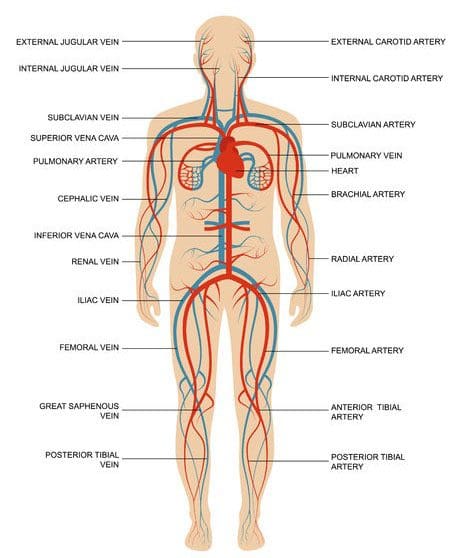A healthy lifestyle combined with exercise creates toned muscles that protect the body/spine and improve blood circulation. Chiropractic is designed to bring pain relief, realign the spine, and restore the body to its natural balance through treatment and a strengthening program.
Spinal Blood Supply
The vascular system's function is to nourish every cell in the body. This includes the:- Vertebral column
- Spinal cord
- Neural structures
- Muscles
Blood
Blood contains:- Plasma - fluid
- Red blood cells - erythrocytes
- White blood cells
- Platelets
Plasma and Cell Nourishment
Plasma, or the liquid part of blood, total's to about 90% of blood combined with water, salts, hormones, and proteins. It delivers the proteins, fats, minerals, and lipids to each cell in the body. Cells can't reproduce or repair any damage or injury to the body without nutrient replenishment.Red Blood Cells/Oxygen
The primary benefit cells derive from blood is oxygen. Oxygen is needed to burn glucose for energy. This oxygen comes from red blood cells. Oxygenated blood pumps from the heart through the arteries while deoxygenated blood returns to the heart through the veins. The pulmonary artery is an exception, as it carries deoxygenated blood from the heart to the lungs and is reoxygenated there. The pulmonary vein then takes the oxygenated blood back to the heart from the lungs.Then the oxygenated blood gets circulated throughout the body.White Blood Cells/Immunity
White blood cells are the components of the immune system and fight infection/s and bacterial toxins.There are different types of white blood cells, these include:
- Neutrophils
- Eosinophils
- Lymphocytes
- Basophils
- Monocytes
Platelets/Clotting
Platelets control bleeding from injury/s by creating a clot, through a series of chemical reactions. The spine is served by the body’s system of arteries and veins.Strengthening
Exercise instructions for specific conditions are given by a physical therapist or chiropractor. The following exercise tips apply to everyone. Remember injury prevention is key for a healthy body.Warm-Up
Before starting any exercise, it's important to warm up. A series of dynamic moves can boost your heart rate and warm up the muscles during your work out. Select whole-body movements like leg lunges combined with arm motion or walk in place while raising and lowering your arms. Once you've warmed up, you can stretch without risk of injury.Appropriate Footwear
When buying tennis shoes, check for stability, flexibility, and comfort. During your test walk, make sure that the shoes feel firm and move through your entire range of motion for a stable gait. Footwear should be flexible enough to give easily at the base of the toe for a smooth gait, and there should be cushioning at all the right places with plenty of room for the toes to move. Shoes that properly fit your feet means that your walk will be more natural and healthy during exercise and in motion.Keep Posture In Mind
Perhaps the biggest reason that these exercise tips are so important is that strong and flexible muscles will help you have proper posture. Be mindful of the following as you move:- When sitting, the feet should be on the floor, shoulders should be relaxed, and forearms should remain parallel with the ground.
- If standing for an extended time, make sure to maintain posture by tucking the stomach muscles in.
- When standing for a very long time, shift the weight from one foot to the other and from the heels to the toes and back again.
Stretch Muscles
Finally, it is important to target large muscle groups with passive exercises. Use your weight to slowly stretch your hamstrings, piriformis, and entire back. Passive stretching is gentle and relieves stress points that cause back pain. These gentle exercises provide a great deal of relief and are easily adjusted to fit your fitness level.A chiropractor will work with you to create an exercise program that is optimal for you. Be sure to follow through with the plan and include these tips in your regular work out.
Sit-Ups/Crunches/Planks and the like
We have ligaments that connect bone to bone, and tendons that connect muscles to bones. All of these structures work together to help move and to stay balanced. Strengthening one area of your body, like the spine, should include strengthening the surrounding areas where the spine really takes the weight. And that is the core.For the back, abdominal strengthening is important because the abs act as a front/forward anchor for the spine. They work as a counterbalance for the back muscles which means that both muscle groups need to be strong to keep the spine properly supported. If the abdominal muscles are weak then the back muscles have to work harder to support the spine.
This can lead to sprains or strains, and back pain. Strengthen, stretch, and stabilize the muscles. These are the keys to keeping the spine healthy. Building up muscle strength, keeping muscles flexible, and working on the core will help stabilize the spine. A physical therapy exercise program includes strengthening, stretching, and stabilization specific to each individual's condition. Don't skip the abdominal exercises when dealing with back pain, they will help in the long run!







